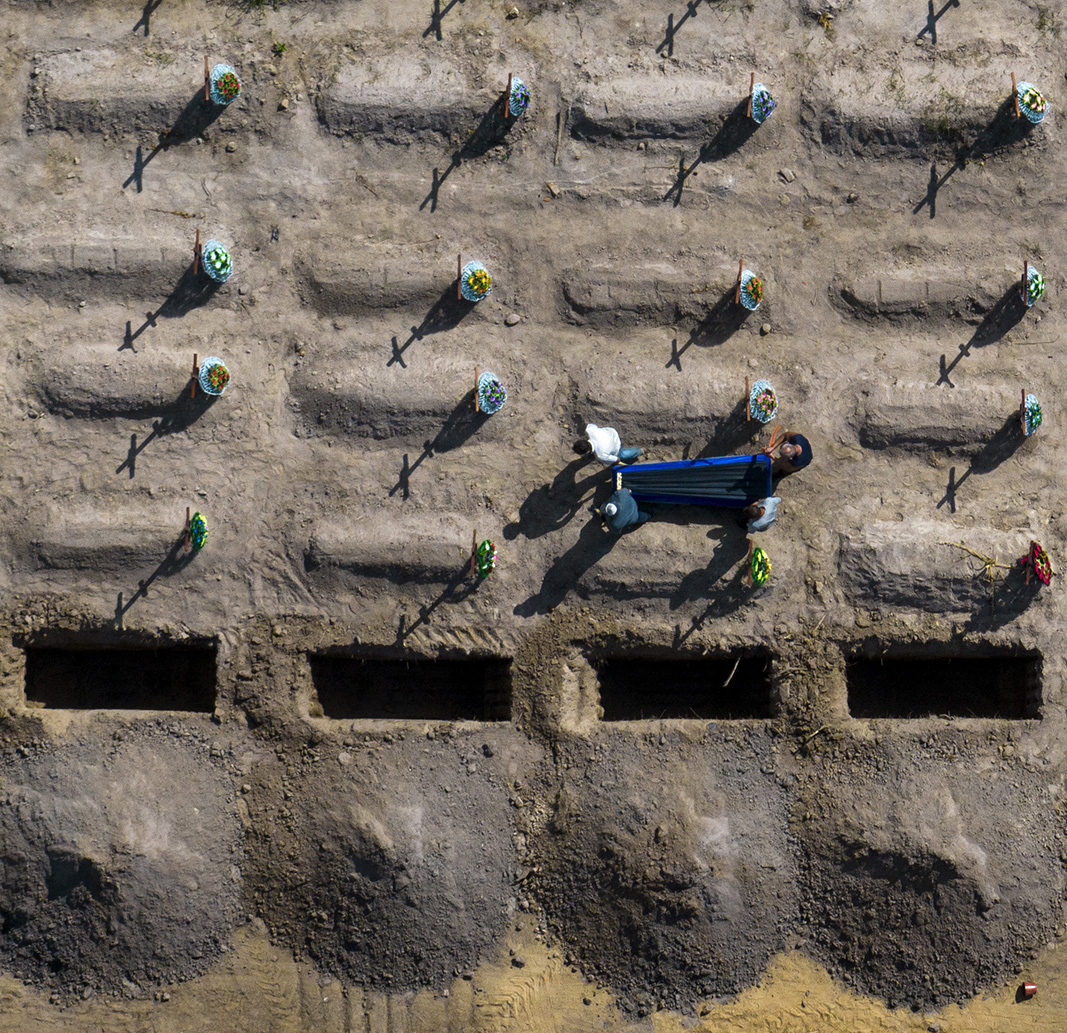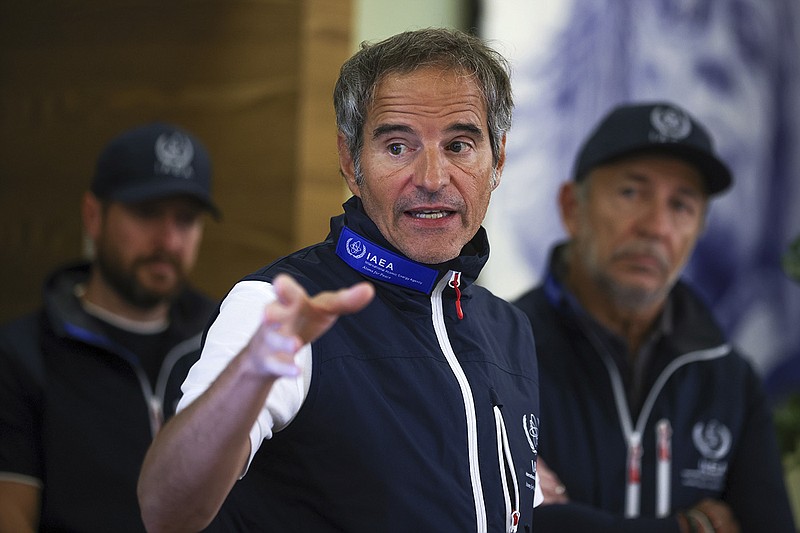ZAPORIZHZHIA, Ukraine -- The gravest risk to the embattled Zaporizhzhia Nuclear Power Plant is physical damage to equipment from shelling that could lead to a release of radiation, the director of the United Nations' nuclear watchdog agency said Friday after a visit to the site.
Other risks abound, International Atomic Energy Agency Director-General Rafael Grossi told reporters in Vienna, a day after inspecting the nuclear station in southern Ukraine.
The plant, has been occupied by Russian forces but run by Ukrainian engineers since the early days of the 6-month war. Loss of external power to cool reactor cores and stress on the operating staff also pose dangers, he said.
"It is obvious there is a lot of fighting in general in this part of Ukraine," Grossi said. "The military activity and operations are increasing in that part of the country, and this worries me a lot."
Grossi said Friday six of the agency's experts remain at the plant and there will be a "permanent presence on site ... with two of our experts who will be continuing the work." He wasn't specific about how long exactly the two experts will stay.
Most of the damage from the war at the sprawling station, which is the largest nuclear plant in Europe, occurred during shelling in August, Grossi said, unless one considers the destruction from the battle in March when the Russian army captured the site.
The Zaporizhzhia plant, now a site of raging battles along a front line, became this year the first active nuclear plant to be caught in a combat zone in the history of civilian nuclear power.
Overall, not one of what the nuclear monitoring agency calls the seven pillars of nuclear safety, which include physical integrity, reliable external power and availability of spare parts, remains intact, Grossi said.
Before the war, the plant provided 30% of Ukraine's electricity. But on some points, the agency's initial assessment was more optimistic than the picture painted by Ukrainian officials, who had said that engineers and other employees had been subjected to harsh interrogation and even torture, raising stress levels when they returned to work in reactor control rooms and in other critical jobs.
Grossi said there was a "professional modus vivendi" at the site. He said it was "admirable for the Ukrainian experts to continue to work in these conditions."
Before the visit, Ukrainian officials said the agency should discount anything employees at the plant said, arguing they are essentially hostages.
Grossi said the Ukrainian and Russian nuclear engineers had managed to "cope" in operating the site and that he was less worried about disruptions in regulatory oversight and supplies of spare parts, although those problems also loomed as risks.
He spoke after he and a team of inspectors crossed a front line in Russia's war in Ukraine to conduct an inspection. Their mission was delayed by artillery strikes on their planned route, part of a swirl of chaotic violence in and around the station.
Grossi said his assessment was bound to disappoint both sides for declining to place blame on one or another army for the shells hitting the plant.
"I don't want to pretend what we are doing will end this terrible war or give back this plant to Ukraine," he said. The mission was limited to gauging nuclear safety, something he said the two-man team remaining at the site would do.
"Now, when there is an allegation that something has happened at the plant, you can turn to us," he said, rather than weighing the conflicting claims of Russia and Ukraine. "That's the difference." He said Russian soldiers had not blocked access to areas of the site he asked to visit.
Asked to compare the potential fallout from a radiation release at Zaporizhzhia with the fire and meltdown at the Chernobyl nuclear plant in 1986, which spread radiation around Europe in the world's worst civilian nuclear accident, Grossi said designs of the two power stations are not comparable. Zaporizhzhia's reactors have containment vessels to limit radiation release. But he said disruptions in external power to cool reactor cores could lead to a meltdown.
"It could be a big thing or a small thing, depending on the damage" from the fighting, he said.
REACTOR RESTARTED
The head of Ukraine's nuclear watchdog, Oleh Korikov, said Ukrainian officials "would like more decisive actions and statements" from the International Atomic Energy Agency inspectors. "But let's wait until the mission is over," he added.
Local Russian-appointed authorities said Friday staff at the plant restarted a key reactor just hours after shelling a day earlier forced it to shut down. Ukraine's nuclear energy operator, Energoatom confirmed on its Telegram channel that the reactivated reactor had been plugged back into the power grid.
Aleksandr Volga, the Kremlin-backed mayor of Enerhodar, where the Zaporizhizhia plant is located, told the Interfax news agency that the facility now had two working reactors, out of a total of six.
The head of Ukraine's powerful National Security Council, Oleksiy Danilov, said Ukrainian authorities weren't fully aware of the situation inside the plant for now -- despite the presence of the International Atomic Energy Agency team that went in Thursday.
In an interview with The Associated Press, Danilov said: "I want to emphasize that this is a challenge for the whole world, how to make this nuclear facility not dangerous."
Britain's Defense Ministry said earlier Friday shelling continued in the area near the plant. Ukrainian President Volodymyr Zelenskyy's office said Russian shelling damaged houses, gas pipelines and other infrastructure on the other bank of the Dnieper River -- part of fighting in several areas of eastern and southern Ukraine overnight.
Russian-backed officials in Enerhodar claimed Russian forces had shot down an armed Ukrainian drone near the plant Friday.
"Ukrainian militants, apparently, continue to try to attack the plant despite the fact that there are IAEA employees there," the press service of the municipal administration said in a statement.
In its regular update Friday, the Ukrainian military said it had carried out a "precision strike" in Enerhodar, but did not acknowledge or directly respond to the claims by Kremlin-backed officials. It said the attack destroyed three artillery systems, an ammunition depot and a company of personnel.
Russia and Ukraine traded accusations that the other side was trying to impede the work of the International Atomic Energy Agency experts, or control the message.
In a conference call with reporters on Friday, Kremlin spokesman Dmitry Peskov said Moscow considered "positively" the arrival of the mission, "despite all problems and difficulties caused by the Ukrainian side's provocative actions."
Ukraine alleges Russia is using the plant as a shield to launch attacks. On Friday, Russian Defense Minister Sergei Shoigu rejected the Ukrainian allegations and said Russia has no heavy weapons either on the site or in nearby areas.
Shoigu said Ukrainian forces have fired 120 artillery shells and used 16 suicide drones to hit the plant, "raising a real threat of a nuclear catastrophe in Europe."
Elsewhere in Ukraine, Zelenskyy's office said four people were killed Friday and 10 injured over the past day in the eastern Donetsk region.
Information for this article was contributed by Andrew E. Kramer of The New York Times and by Yesica Fisch, Joanna Kozlowska and Geir Moulson of The Associated Press.
 During funeral services Friday in Bucha, outside the Ukraine capital of Kyiv, workers carry the coffin of an unidentified civilian killed during the Russian occupation of Bucha early in the war. Meanwhile, nuclear experts said Friday that the embattled nuclear plant in Zaporizhzhia, Ukraine, is at risk of a radiation leak as battles rage around it. (AP/Emilio Morenatti)
During funeral services Friday in Bucha, outside the Ukraine capital of Kyiv, workers carry the coffin of an unidentified civilian killed during the Russian occupation of Bucha early in the war. Meanwhile, nuclear experts said Friday that the embattled nuclear plant in Zaporizhzhia, Ukraine, is at risk of a radiation leak as battles rage around it. (AP/Emilio Morenatti)